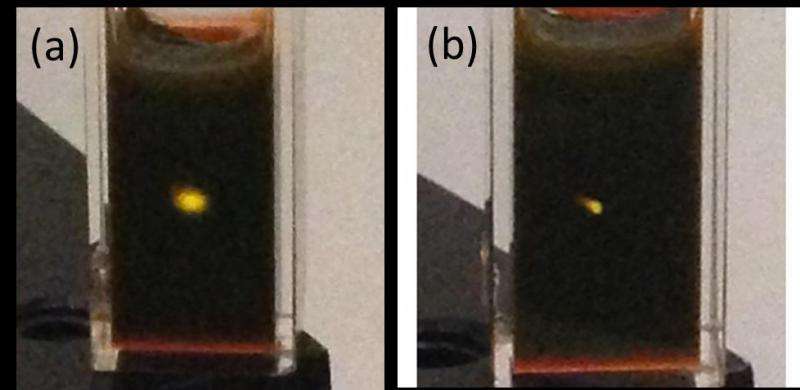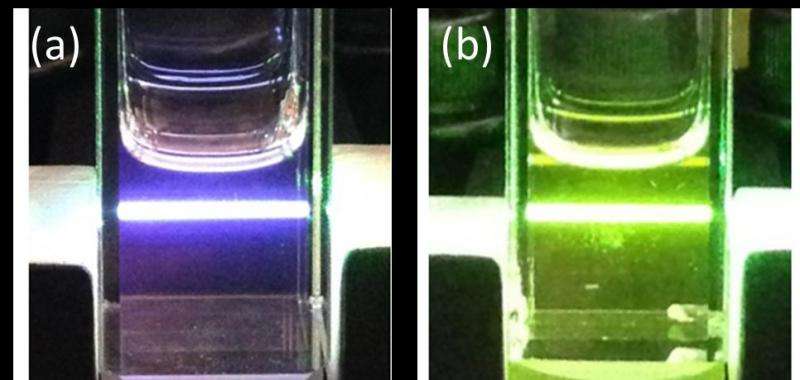Reshaping the solar spectrum to turn light to electricity

When it comes to installing solar cells, labor cost and the cost of the land to house them constitute the bulk of the expense. The solar cells—made often of silicon or cadmium telluride—rarely cost more than 20 percent of the total cost. Solar energy could be made cheaper if less land had to be purchased to accommodate solar panels, best achieved if each solar cell could be coaxed to generate more power.
A huge gain in this direction has now been made by a team of chemists at the University of California, Riverside that has found an ingenious way to make solar energy conversion more efficient. The researchers report in Nano Letters that by combining inorganic semiconductor nanocrystals with organic molecules, they have succeeded in "upconverting" photons in the visible and near-infrared regions of the solar spectrum.
"The infrared region of the solar spectrum passes right through the photovoltaic materials that make up today's solar cells," explained Christopher Bardeen, a professor of chemistry. The research was a collaborative effort between him and Ming Lee Tang, an assistant professor of chemistry. "This is energy lost, no matter how good your solar cell. The hybrid material we have come up with first captures two infrared photons that would normally pass right through a solar cell without being converted to electricity, then adds their energies together to make one higher energy photon. This upconverted photon is readily absorbed by photovoltaic cells, generating electricity from light that normally would be wasted."
Bardeen added that these materials are essentially "reshaping the solar spectrum" so that it better matches the photovoltaic materials used today in solar cells. The ability to utilize the infrared portion of the solar spectrum could boost solar photovoltaic efficiencies by 30 percent or more.

In their experiments, Bardeen and Tang worked with cadmium selenide and lead selenide semiconductor nanocrystals. The organic compounds they used to prepare the hybrids were diphenylanthracene and rubrene. The cadmium selenide nanocrystals could convert visible wavelengths to ultraviolet photons, while the lead selenide nanocrystals could convert near-infrared photons to visible photons.
In lab experiments, the researchers directed 980-nanometer infrared light at the hybrid material, which then generated upconverted orange/yellow fluorescent 550-nanometer light, almost doubling the energy of the incoming photons. The researchers were able to boost the upconversion process by up to three orders of magnitude by coating the cadmium selenide nanocrystals with organic ligands, providing a route to higher efficiencies.
"This 550—nanometer light can be absorbed by any solar cell material," Bardeen said. "The key to this research is the hybrid composite material—combining inorganic semiconductor nanoparticles with organic compounds. Organic compounds cannot absorb in the infrared but are good at combining two lower energy photons to a higher energy photon. By using a hybrid material, the inorganic component absorbs two photons and passes their energy on to the organic component for combination. The organic compounds then produce one high-energy photon. Put simply, the inorganics in the composite material take light in; the organics get light out."
Besides solar energy, the ability to upconvert two low energy photons into one high energy photon has potential applications in biological imaging, data storage and organic light-emitting diodes. Bardeen emphasized that the research could have wide-ranging implications.
"The ability to move light energy from one wavelength to another, more useful region, for example, from red to blue, can impact any technology that involves photons as inputs or outputs," he said.
More information: Nano Letters, pubs.acs.org/doi/full/10.1021/acs.nanolett.5b02130
Journal information: Nano Letters
Provided by University of California - Riverside




















